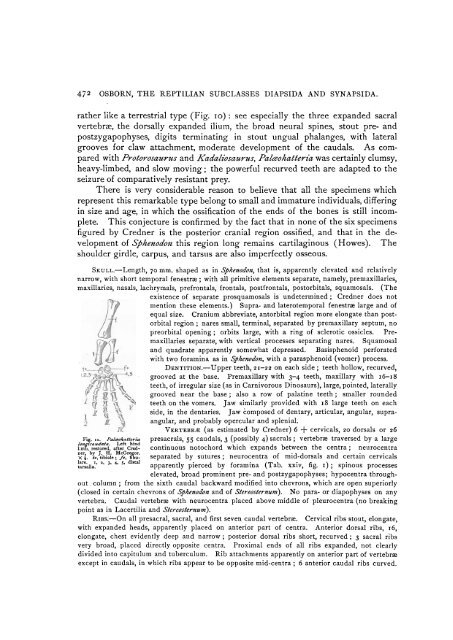American Museum of Natural History
American Museum of Natural History
American Museum of Natural History
Create successful ePaper yourself
Turn your PDF publications into a flip-book with our unique Google optimized e-Paper software.
472 OSBORN, THE REPTILIAN SUBCLASSES DIAPSIDA AND SYNAPSIDA.<br />
rather like a terrestrial type (Fig. io): see especially the three expanded sacral<br />
vertebrae, the dorsally expanded ilium, the broad neural spines, stout pre- and<br />
postzygapophyses, digits terminating in stout ungual phalanges, with lateral<br />
grooves for claw attachment, moderate development <strong>of</strong> the caudals. As compared<br />
with Pro/orosaurus and Kadaliosaurus, Palaohadleria was certainly clumsy,<br />
heavy-limbed, and slow moving; the powerful recurved teeth are adapted to the<br />
seizure <strong>of</strong> comparatively resistant prey.<br />
There is very considerable reason to believe that all the specimens which<br />
represent this remarkable type belong to small and immature individuals, differing<br />
in size and age, in which the ossification <strong>of</strong> the ends <strong>of</strong> the bones is still incomplete.<br />
This conjecture is confirmed by the fact that in none <strong>of</strong> the six specimens<br />
figured by Credner is the posterior cranial region ossified, and that in the development<br />
<strong>of</strong> Sphenodou this region long remains cartilaginous (Howes). The<br />
shoulder girdle, carpus, and tarsus are also imperfectly osseous.<br />
SKULL.-Length, 70 mm. shaped as in Sphenodon, that is, apparently elevated and relatively<br />
narrow, with short temporal fenestrx; with all primitive elements separate, namely, premaxillaries,<br />
maxillaries, nasals, lachrymals, prefrontals, frontals, postfrontals, postorbitals, squamosals. (The<br />
existence <strong>of</strong> separate prosquamosals is undetermined; Credner does not<br />
X mention these elements.) Supra- and laterotemporal fenestre large and <strong>of</strong><br />
equal size. Cranium abbreviate, antorbital region more elongate than postorbital<br />
region ; nares small, terminal, separated by premaxillary septum, no<br />
preorbital opening; orbits large, with a ring <strong>of</strong> sclerotic ossicles. Premaxillaries<br />
separate, with vertical processes separating nares. Squamosal<br />
and quadrate apparently somewhat depressed. Basisphenoid perforated<br />
with two foramina as in Sphenodon, with a parasphenoid (vomer) process.<br />
tV -f DENTITION.-Upper teeth, 21-22 on each side; teeth hollow, recurved,<br />
32,

















